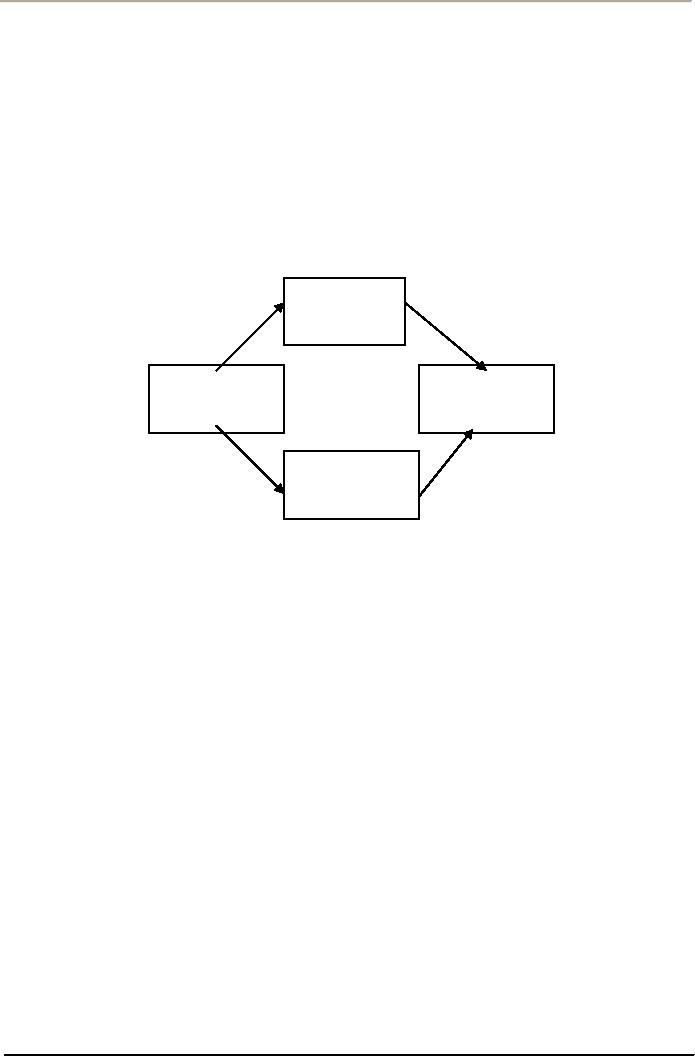 |

Total
Quality Management
MGT510
VU
Lesson
# 44
UNDERSTANDING
EMPOWERMENT FOR TQ AND
CUSTOMER-SUPPLIER
RELATIONSHIP
Introduction
to Empowerment
Empowerment
means giving someone
power-granting the authority to do
whatever is necessary to
satisfy
customers, and trusting employees to make the
right choices without
waiting for
management
approval.
By empowering employees, organizations
drive decision making down
to its lowest possible
level.
Empowerment allows organizations to
flatten their organizational structure
because fewer
managers
are needed to "direct and
control" employees. Many companies have
found that giving
people
throughout
the organization the power to make a
difference contributes greatly to
providing quality
products
and services to their customers.
The need to empower the entire
workforce in order for
quality
to
succeed has long been
recognized, even if it is only recently
coming into practice. Five of
Deming's
14
Points relate directly to the nation of
empowerment.
Point
6:
Institute
training
Point
7:
Teach
and institute leadership
Point
8:
Drive
out fear. Create trust.
Create a climate for
innovation
Point
10:
Eliminate
exhortations for the
workforce.
Point
13:
Encourage
education and self-improvement for
everyone
Juran
wrote that "ideally, quality
control should be delegated to the
workforce to the maximum
extent
possible."
Empowerment resembles Juran's
concept of "self-control." For employees
to practice self-
control,
they must know their
unit's goals and their actual performance and have a
means for changing
performance
if the goals are not being
met. Although it is a difficult
struggle, organizations
are
increasingly
meeting these conditions.
Empowerment is a natural extension of
employee involvement
concepts
such as worker participation in
decision making. In some
companies empowerment is used as
the
umbrella term for increasing
employee involvement in decision
making. Empowerment is more
than
another
term for involvement,
however. It represents a high
degree of involvement in which
employees
make
decisions themselves and are responsible
for their outcomes. This is
a more radical change
than
having
employees merely participate in managers' decisions,
even when they are given
some influence.
For
empowerment to occur, managers must
undertake tow major
initiatives:
·
Identify
and change organizational conditions
that make people powerless,
and
·
Increase
people's confidence that
their efforts to accomplish something
important will be
successful.
The
need to do both of these
implies that organizational
system often creates
powerless employees and
that
these systems must be
changed first. Examples of systems in
need of change are those
that specify
who
can (and cannot) make
certain types of decisions and systems of
standard operating
procedures
(and
who can override
them).
Continuum
of Employee Involvement Practices
Participation
Empowerment
Low
High
Involvement
Small
Large
Change
from Traditional Organizational
Style
175

Total
Quality Management
MGT510
VU
Even
when systems are changed to
permit empowerment, individuals who have
lived under those
systems
are not readily able to
operate in an empowered manner. The other
need for empowering
people
is
to deal with the psychological
aftereffects of powerlessness by
convincing people that they
are in fact
able
to "make a difference."
Empowerment
is an application of the teamwork
principle of total quality,
embodying "vertical"
teamwork
between managerial and non managerial
personnel. If employees are given
important
responsibilities
and the authority that goes
along with them it is more
realistic to describe
their
relationship
with management as teamwork
than it would be in hierarchical
system. After all, people
can
hardly
be seen as team members if
they only execute decisions
made by others.
How
Empowerment Leads To
Quality
Continuous
Improvement
Quality
Products
and
Customer
Empowerment
Service
Job
Satisfaction
Everyone
in organizations is an asset, albeit an
asset whose value is not
automatically realized. If
money
is
put into a closet instead of a
bank, it will not gain
interest. Employees who are put
into jobs that
are
like
being in a closet (in the
dark, isolated) similarly
will not provide value to
the organization. Giving
employees
responsibility for their own
work has led not
only to improvements in motivation,
customer
service,
and morale, but also to
improvements in quality, productivity,
and the speed of decision
making.
Principles
of Empowerment
Although
many organizations have undertaken the
journey toward empowerment, many have
become
lost
along the way. Semi empowerment just
doesn't work. Senior
managers need to ask three
critical
questions:
1.
How
can I make fewer decisions,
thereby letting others
become more involved in
managing
the
business?
2.
How
can teach others how to
make solid decisions once
they're given the
chance?
3.
How
can I recruit others to be more
aware of changes that need
to be made in order to keep
our
company competitive and then help
them feel they can make
these changes without
begging
for permission each and every
time?
This
does not mean that there
should be no limits. On the contrary,
managers must be clear on
exactly
what
responsibility and authority rests
with employees. Questions such as
"What procedures can
we
change?"
and "how much money
can we commit?" must be
answered ahead of time.
Finally, managers
must
be willing to wait for
results, as miracles do not happen
overnight.
176

Total
Quality Management
MGT510
VU
Establishment
Mutual Trust
As
Juran has put it, "The
managers must trust the
workforce enough to be willing to make
the
delegation,
and the workforce must have
enough confidence in the managers to be
willing to accept the
responsibility."
Trust is not created just by
saying you trust someone; it
must be backed up by actions.
Provide
Employees wit Business
Information
For
empowerment to succeed, it must focus on
making the organization more
competitive.
Empowerment
can contribute to organizational
performance only if employees have access to
the
necessary
information about the business and
its performance, such as their personnel
files and
resources
such as the quality improvement
budget. Information about the
employees' department or
other
subunit is particularly necessary, as
this is the level of performance that
they can affect.
Sharing
business
information with employees relates
directly to quality, customer service,
and competitiveness.
In
the absence of appropriate information,
empowered employees may squander their
power on
problems
that are not very
important. As Peter Senge
has put it, "empowering the
individual where there
is
a relatively low level of
alignment [between organizational
and employee goals] worsens
the chaos
and
makes managing . . . even more
difficult."Te criticism of misplaced goals
was often leveled at
earlier
employee-involvement efforts, such as
quality circles. Although managers
formerly blamed
employees
for having the wrong
priorities, sophisticated managers today
recognize that they
are
responsible
for providing employees with the
information necessary to develop
educated priorities.
Ensure
That Employees Are
Capable
"You
can't empower incompetence," says
one manager. If employees are going to
take on important
organizational
responsibilities, they must be prepared t
do so. To operate in an empowered, TQ
environment,
employees must possess not
only technical skills
(including statistics) but
also
interpersonal
and problem-solving skills.
Unfortunately, many people
entering the workforce today
lack
even
the most basic skills in
reading and math, let alone
these relatively advanced
skills.
Employee
capability can be ensured
through selection and training processes.
Unless the human
resource
processes are adapted to
provide capable employees, empowerment cannot
succeed, and
management's
worst nightmares will be realized.
Unfortunately, many employees are
not trained in
these
areas, which helps explain the
mixed results many
organizations have had with
empowerment.
Empowerment
also requires that employees understand
their appropriate limits of
discretion.
Don't
Ignore Middle
Management
A
well-known principle of organization
theory popularized by Deming is
that organizations are
systems.
When
changing one part of an organization, it
is necessary to consider the effects of the change on
other
parts
of the system. Thus, managers must
consider how empowering lower-level
employees will affect
middle
managers. If the needs and expectations
of middle manager are
ignored, empowerment will be
confusing
at best and disastrous at worst.
Among the roles for middle
managers in organizations
with
empowered
workforces are
·
Maintaining
focus on the organization's values,
·
Managing
solutions to system-level problems (those
that involve many functions
and
departments),
and
·
Acting
as teachers and coaches.
It's
tempting to think of middle
managers faced with empowerment efforts
as dinosaurs, rapidly
becoming
extinct because the world
has changed too quickly
for them. However, remember
that most
middle
managers are a product of
their organizations and have attained
their level of success in
an
177

Total
Quality Management
MGT510
VU
environment
that rewarded different things
than are needed from
managers now. Given a new
set of
instructions
from top management, backed up by
new performance appraisal criteria. Many
(but far
from
al) managers will be able to
make the necessary transition.
Change
the Reward System
Rarely
can substantial organizational change be
created without changing the
reward system. When
organizations
ask employees to assume new challenges
and responsibilities, the question
"What's init
for
me?" ultimately gets asked.
The reward system includes
all of the rewards that employees
receive, as
well
as the criteria for distributing
these rewards. An organization is to
its reward system like a
boat is to
its
anchor: unless the reward system is
changed, the organization may
drift a little bit in one
direction or
another,
but it won't get very
far.
It
is hard to specify exactly what
kind of reward systems will
be needed to complement empowerment.
Some
of the practices common to organizations
utilizing employee involvement
include pay-for-skills,
in
which employees' pay
increases as they learn new
job-relevant skills, and
profit sharing, in which
employees
receive bonuses related to the
profits of their
organization.
Quality
in Customer-Supplier Relationships
Businesses
have recognized that supply chain
management is crucial for
effective operations and
meeting
customer needs. A supply
chain includes the materials and
other inputs purchased
from
suppliers,
their use in the production of
goods and services, and distribution and
service to customers.
Quality
should start with the customer, and
extend back through the supply
chain to the root sources
of
procurement.
Customer-Supplier
Relationship and Total
Quality
From
the TQ perspective, every company is part of a
long chain (actually many
long chains) of
customers
and suppliers. Each company is a customer
to its suppliers and a supplier to
its customers, so
it
does not make sense to
think of a company as only one or the
other. One implication of
this concept is
that
your customer's customers are, in a
sense, your customers as
well. Sometimes a company
must
focus
on both their immediate
customers and those next in the
chain. Procter & Gamble, for
example,
works
hard to satisfy the needs of both the
people who use their
products and the retail
establishments
that
sell them, labeling the former
"consumers" and the latter
"customers."
Companies
should try to establish the same
kinds of productive relationships
with their suppliers
that
they
have with their customers. By
developing partnerships, customers and suppliers
can build
relationships
that will help them satisfy
their shared customers
further along the
customer-supplier
chain.
The idea of creating
mutually beneficial relationships
with both customers and suppliers is
a
major
departure from the traditional approach to
customer and supplier relationships
(CSRs).
The
Customer-Supplier Chain
Customer/
Customer/
Supplier
Supplier
Customer/
(Coal
Mine)
Customer/
Supplier
(Steel
mill)
Supplier
(Auto
plant)
(Car
rental agency)
178
Table of Contents:
- OVERVIEW OF QUALITY MANAGEMENT:PROFESSIONAL MANAGERIAL ERA (1950)
- TOTAL QUALITY MANAGEMENT AND TOTAL ORGANIZATION EXCELLENCE:Measurement
- INTEGRATING PEOPLE AND PERFORMANCE THROUGH QUALITY MANAGEMENT
- FUNDAMENTALS OF TOTAL QUALITY AND RATERS VIEW:The Concept of Quality
- TOTAL QUALITY MANAGEMENT AND GLOBAL COMPETITIVE ADVANTAGE:Customer Focus
- TOTAL QUALITY MANAGEMENT AND PLANNING FOR QUALITY AT OFFICE
- LEADERS IN QUALITY REVOLUTION AND DEFINING FOR QUALITY:User-Based
- TAGUCHI LOSS FUNCTION AND QUALITY MANAGEMENT
- WTO, SHIFTING FOCUS OF CORPORATE CULTURE AND ORGANIZATIONAL MODEL OF MANAGEMENT
- HISTORY OF QUALITY MANAGEMENT PARADIGMS
- DEFINING QUALITY, QUALITY MANAGEMENT AND LINKS WITH PROFITABILITY
- LEARNING ABOUT QUALITY AND APPROACHES FROM QUALITY PHILOSOPHIES
- TOTAL QUALITY MANAGEMENT THEORIES EDWARD DEMING’S SYSTEM OF PROFOUND KNOWLEDGE
- DEMING’S PHILOSOPHY AND 14 POINTS FOR MANAGEMENT:The cost of quality
- DEMING CYCLE AND QUALITY TRILOGY:Juran’s Three Basic Steps to Progress
- JURAN AND CROSBY ON QUALITY AND QUALITY IS FREE:Quality Planning
- CROSBY’S CONCEPT OF COST OF QUALITY:Cost of Quality Attitude
- COSTS OF QUALITY AND RETURN ON QUALITY:Total Quality Costs
- OVERVIEW OF TOTAL QUALITY APPROACHES:The Future of Quality Management
- BUSINESS EXCELLENCE MODELS:Excellence in all functions
- DESIGNING ORGANIZATIONS FOR QUALITY:Customer focus, Leadership
- DEVELOPING ISO QMS FOR CERTIFICATION:Process approach
- ISO 9001(2000) QMS MANAGEMENT RESPONSIBILITY:Issues to be Considered
- ISO 9001(2000) QMS (CLAUSE # 6) RESOURCES MANAGEMENT:Training and Awareness
- ISO 9001(2000) (CLAUSE # 7) PRODUCT REALIZATION AND CUSTOMER RELATED PROCESSES
- ISO 9001(2000) QMS (CLAUSE # 7) CONTROL OF PRODUCTION AND SERVICES
- ISO 9001(2000) QMS (CLAUSE # 8) MEASUREMENT, ANALYSIS, AND IMPROVEMENT
- QUALITY IN SOFTWARE SECTOR AND MATURITY LEVELS:Structure of CMM
- INSTALLING AN ISO -9001 QM SYSTEM:Implementation, Audit and Registration
- CREATING BUSINESS EXCELLENCE:Elements of a Total Quality Culture
- CREATING QUALITY AT STRATEGIC, TACTICAL AND OPERATIONAL LEVEL
- BIG Q AND SMALL q LEADERSHIP FOR QUALITY:The roles of a Quality Leader
- STRATEGIC PLANNING FOR QUALITY AND ADVANCED QUALITY MANAGEMENT TOOLS
- HOSHIN KANRI AND STRATEGIC POLICY DEPLOYMENT:Senior Management
- QUALITY FUNCTION DEPLOYMENT (QFD) AND OTHER TOOLS FOR IMPLEMENTATION
- BASIC SQC IMPROVEMENT TOOLS:TOTAL QUALITY TOOLS DEFINED
- HOW QUALITY IS IMPLEMENTED? A DIALOGUE WITH A QUALITY MANAGER!
- CAUSE AND EFFECT DIAGRAM AND OTHER TOOLS OF QUALITY:Control Charts
- STATISTICAL PROCESS CONTROL (SPC) FOR CONTINUAL QUALITY IMPROVEMENT
- STATISTICAL PROCESS CONTROL….CONTD:Control Charts
- BUILDING QUALITY THROUGH SPC:Types of Data, Defining Process Capability
- AN INTERVIEW SESSION WITH OFFICERS OF A CMMI LEVEL 5 QUALITY IT PAKISTANI COMPANY
- TEAMWORK CULTURE FOR TQM:Steering Committees, Natural Work Teams
- UNDERSTANDING EMPOWERMENT FOR TQ AND CUSTOMER-SUPPLIER RELATIONSHIP
- CSR, INNOVATION, KNOWLEDGE MANAGEMENT AND INTRODUCING LEARNING ORGANIZATION